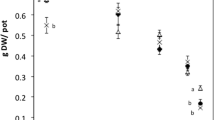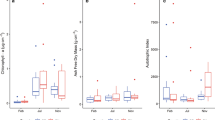Abstract
The aquatic nuisance species Didymosphenia geminata was first documented in Rapid Creek of South Dakota’s Black Hills during 2002. Since then, blooms have occurred primarily in a 39-km section of Rapid Creek while blooms were rarely observed in other Black Hills streams. In this study, we evaluated factors related to the presence and development of visible colonies of D. geminata in four streams of the Black Hills. At the watershed scale, stream gradient was negatively associated with the occurrence of D. geminata whereas stream width was positively related to D. geminata presence. At the stream scale, D. geminata coverage was inversely related to canopy coverage and iron concentration. At the local scale, shading by bridges virtually eliminated growth of D. geminata colonies under bridges. At all three scales, proxy measures of light such as stream width, canopy coverage, and bridge shading revealed that light availability was an important factor influencing the presence and coverage of D. geminata colonies. In general, streams that had relatively wide stream reaches (mean = 9.9 m), shallow gradients (mean = 0.22%), and little canopy cover (mean = 13%) were associated with D. geminata blooms. In addition, iron concentrations in streams with D. geminata colonies were lower than in streams without blooms.





Similar content being viewed by others
References
APHA, 2002. Standard methods for the examination of water and wastewater, 20th edn. American Public Health Association, United Book Press, Baltimore.
Blanco, S. & L. Ector, 2009. Distribution, ecology and nuisance effects of the freshwater invasive diatom Didymosphenia geminata (Lyngbye) M. Schmidt: a literature review. Nova Hedwigia 88: 347–422.
Bothwell, M. L. & C. Kilroy, 2011. Phosphorous limitation of the freshwater benthic diatom Didymosphenia geminata determined by the frequency of dividing cells. Freshwater Biology 56: 565–578.
Bothwell, M. L., D. Sherbot, A. C. Roberge & R. J. Daley, 1993. Influence of natural ultraviolet radiation on lotic periphytic diatom community growth, biomass accrual, and species composition: short-term versus long-term effects. Journal of Phycology 29: 24–35.
Bothwell, M. L., C. Kilroy, B. W. Taylor, E. T. Ellison, D. A. James, C. A. Gillis, K. D. Bladon & U. Silins, 2012. Iron is not responsible for Didymosphenia geminata bloom formation in phosphorus-poor rivers. Canadian Journal of Fisheries and Aquatic Sciences 69: 1723–1727.
Caldwell, M. M., R. Robberecht & W. D. Billings, 1980. A steep latitudinal gradient of solar ultraviolet-B radiation in the arctic-alpine life zone. Ecology 61: 600–611.
Cody, R. P. & J. K. Smith, 2006. Applied Statistics and the SAS Programming Language, 5th edn. Pearson Prentice Hall, Upper Saddle River.
Cullis, J. D. S., C. Gillis, M. L. Bothwell, C. Kilroy, A. Packman & M. Hassan, 2012. A conceptual model for the blooming behavior and persistence of the benthic mat-forming diatom Didymosphenia geminata in oligotrophic streams. Journal of Geophysical Research 117: G00N03.
Domozych, D. S., M. Toso & A. Snyder, 2010. Biofilm dynamics of the nuisance diatom, Didymosphenia geminata (Bacillariophyceae). Nova Hedwigia, Beiheft 136: 249–259.
Ellwood, N. T. W. & B. A. Whitton, 2007. Importance of organic phosphate hydrolyzed in stalks of the lotic diatom Didymosphenia geminata and the possible impact of atmospheric and climatic changes. Hydrobiologia 592: 121–133.
Fausch, K. D. & R. J. White, 1981. Competition between brook trout and brown trout for positions in a Michigan stream. Canadian Journal of Fisheries and Aquatic Sciences 38: 1220–1227.
Gillis, C. & M. Chalifour, 2009. Changes in the macrobenthic community structure following the introduction of the invasive algae Didymosphenia geminata in the Matapedia River (Quebec, Canada). Hydrobiologia 647: 63–70.
Gorman, O. T. & J. R. Karr, 1978. Habitat structure and stream fish communities. Ecology 59: 507–515.
Gray, B. R. & W. R. Hill, 1995. Nickel sorption by periphyton exposed to different light intensities. Journal of the North American Benthological Society 14: 299–305.
Gretz, M. R., 2008. The stalks of Didymo. In Bothwell, M. L. & S. A. Spaulding (eds), Proceedings of the 2007 International Workshop on Didymosphenia geminata, Vol. 2795. Canadian Technical Report of Fisheries and Aquatic Sciences, Montreal, QC, 21 pp.
Herman, J., 2010. Global increases in UV irradiance during the past 30 years (1979–2008) estimated from satellite data. Journal of Geophysical Research 115: D00L15.
Hill, W. R., 1996. Effects of light. In Stevenson, R. J., M. L. Bothwell & R. L. Lowe (eds), Algal Ecology. Academic Press, San Diego: 121–148.
Hill, W. R., A. T. Bednarek & I. L. Larsen, 2000. Cadmium sorption and toxicity in autotrophic biofilms. Canadian Journal of Fisheries and Aquatic Sciences 57: 530–537.
Hosmer Jr., D. W. & S. Lemeshow, 1989. Applied Logistic Regression. Wiley, New York.
James, D. A., S. H. Ranney, S. R. Chipps & B. D. Spindler, 2010. Invertebrate composition and abundance associated with Didymosphenia geminata in a montane stream. Journal of Freshwater Ecology 25: 235–241.
Kawecka, B. & J. Sanecki, 2003. Didymosphenia geminata in running waters of southern Poland – symptoms of change in water quality? Hydrobiologia 495: 193–201.
Kilroy, C., B. Biggs, N. Blair, P. Lambert, B. Jarvie, K. Dey, K. Robinson & D. Smale, 2005. Ecological Studies of Didymosphenia geminata. National Institute of Water and Atmospheric Research, Client Report CHC2005–123, Christchurch.
Kilroy, C. & M. Bothwell, 2011. Environmental control of stalk length in the bloom-forming, freshwater benthic diatom Didymosphenia geminata (Bacillariophyceae). Journal of Phycology 47: 981–989.
Kilroy, C. & M. Bothwell, 2012. Didymosphenia geminata growth rates and bloom formation in relation to ambient dissolved phosphorus concentration. Freshwater Biology 57: 641–653.
Kilroy, C., S. T. Larned & B. J. F. Biggs, 2009. The non-indigenous diatom Didymosphenia geminata alters benthic communities in New Zealand rivers. Freshwater Biology 54: 1990–2002.
Kirkwood, A. E., T. Shea, L. J. Jackson & E. McCauley, 2007. Didymosphenia geminata in two Alberta headwater rivers: an emerging invasive species that challenges conventional views on algal bloom development. Canadian Journal of Fisheries and Aquatic Sciences 64: 1703–1709.
Kirkwood, A. E., L. J. Jackson & E. McCauley, 2009. Are dams hotspots for Didymosphenia geminata blooms? Freshwater Biology 54: 1856–1863.
Kumar, S., S. A. Spaulding, T. J. Stohlgren, K. A. Hermann, T. S. Schmidt & L. L. Bahls, 2009. Potential habitat distribution for the freshwater diatom Didymosphenia geminata in the continental US. Frontiers in Ecology and the Environment 7: 415–420.
Kutner, M. H., C. J. Nachtsheim & J. Neter, 2004. Applied Linear Regression Models, 4th edn. McGraw-Hill Irwin, New York.
Lawrence, J. R., G. D. W. Swerhone & K. T. Kwong, 1998. Natural attenuation of aqueous metal contamination by an algal mat. Canadian Journal of Microbiology 44: 825–832.
Lemmon, P. E., 1956. A spherical densiometer for estimating forest overstory density. Forestry Science 2: 314–320.
Lemmon, P. E., 1957. A new instrument for measuring forest overstory density. Journal of Forestry 55: 667–668.
Letovsky, E., K. V. Heal, L. Carvalho & B. M. Spears, 2012. Intracellular versus extracellular iron accumulation in freshwater periphytic mats across a mine water treatment lagoon. Water, Air, and Soil Pollution 223: 1519–1530.
Li, H. W., G. A. Lambert, T. N. Pearsons, C. K. Tait, J. L. Li & J. C. Buckhouse, 1994. Cumulative effects of riparian disturbances along high desert trout streams of the John Day basin, Oregon. Transactions of the American Fisheries Society 123: 627–640.
Miller, M. P., D. M. McKnight, J. D. Cullis, A. Greene, K. Vietti & D. Liptzin, 2009. Factors controlling streambed coverage of Didymosphenia geminata in two regulated streams in the Colorado front range. Hydrobiologia 630: 207–218.
Rader, R. B. & T. A. Belish, 1997. Effects of ambient and enhanced UV-B radiation on periphyton in a mountain stream. Journal of Freshwater Ecology 12: 615–628.
Rich C. F., Jr., T. E. McMahon, B. E. Rieman & W. L. Thompson, 2003. Local habitat, watershed, and biotic features associated with bull trout occurrence in Montana streams. Transactions of the American Fisheries Society 132: 1053–1064.
Rost, A. L., C. H. Fritsen & C. J. Davis, 2011. Distribution of freshwater diatom Didymosphenia geminata in streams in the Sierra Nevada, USA, in relation to water chemistry and bedrock geology. Hydrobiologia 665: 157–167.
Segura, P., 2011. A slimy invader blooms in the rivers of Patagonia. Science 331: 18.
Sherbot, D. M. J. & M. L. Bothwell, 1993. A review of the ecology of D. geminata and the physiochemical data of endemic catchments on Vancouver Island. Environmental Sciences Division, National Hydrology Research Institute Contribution 93005: 1–55.
Smith, D. J. & G. J. Underwood, 2000. The production of extracellular carbohydrates by estuarine benthic diatoms: the effects of growth phase and light and dark treatment. Journal of Phycology 36: 321–333.
Spaulding, S. A. & L. Elwell, 2007. Increase in Nuisance Blooms and Geographic Expansion of the Freshwater Diatom Didymosphenia geminata: Recommendations for Response. U.S. Environmental Protection Agency, Denver, Colorado, and Federation of Flyfishers, Livingston.
Staats, N., L. J. Stal, B. de Winder & L. R. Mur, 2000. Oxygenic photosynthesis as driving process in exopolysaccharide production of benthic diatoms. Marine Ecology Progress Series 193: 261–269.
Towns, D. R., 1981. Effects of artificial shading on periphyton and invertebrates in a New Zealand stream. New Zealand Journal of Marine and Freshwater Research 15: 185–192.
United States Geological Survey (USGS), 2008. Water Resource and Stream Flow Data 1943–2007. United State Geological Survey. Available on http://www.usgs.gov/. (January 2008).
Wetzel, R. G. & G. E. Likens, 1991. Limnological Analyses, 2nd edn. Springer-Verlag, New York.
Whitton, B. A., N. T. W. Ellwood & B. Kawecka, 2009. Biology of the freshwater diatom Didymosphenia geminata: a review. Hydrobiologia 630: 1–37.
Zoellick, B. W., 2004. Density and biomass of redband trout relative to stream shading and temperature in southwestern Idaho. Western North American Naturalist 64: 18–26.
Acknowledgments
We thank personnel from the South Dakota Department of Game, Fish and Parks, and South Dakota State University for laboratory and field assistance during this study. J. Stafford provided assistance with statistical analyses. Funding for this project was provided by Federal Aid in Sport Fish Restoration (Project F-15-R 1514) administered by the South Dakota Department of Game, Fish and Parks. Any use of trade names is for descriptive purposes only and does not imply endorsement by the U.S. Fish and Wildlife Service or the U.S. Government.
Author information
Authors and Affiliations
Corresponding author
Additional information
Handling editor: Luigi Naselli-Flores
Rights and permissions
About this article
Cite this article
James, D.A., Mosel, K. & Chipps, S.R. The influence of light, stream gradient, and iron on Didymosphenia geminata bloom development in the Black Hills, South Dakota. Hydrobiologia 721, 117–127 (2014). https://doi.org/10.1007/s10750-013-1654-y
Received:
Revised:
Accepted:
Published:
Issue Date:
DOI: https://doi.org/10.1007/s10750-013-1654-y




